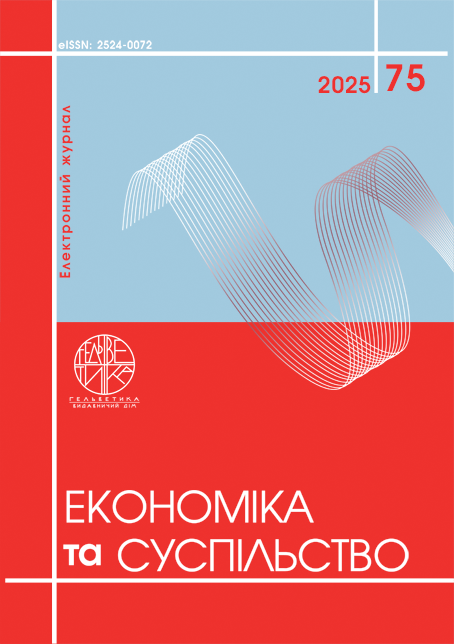THE ROLE OF DIGITAL TRANSFORMATION OF ENTERPRISES IN COUNTERING MODERN DESTABILIZATION CHALLENGES
Abstract
The purpose of the article is to determine the strategic role of digital transformation in enhancing the resilience of enterprises to destabilizing challenges, particularly in the context of the full-scale war in Ukraine. The study emphasizes that traditional management approaches are no longer effective under conditions of military aggression, disrupted supply chains, infrastructure collapse, and continuous uncertainty. Digital transformation is examined not merely as the adoption of new technologies but as a comprehensive strategic process involving changes in business models, internal processes, decision-making systems, customer interactions, and corporate culture. The article analyzes the impact of digital tools such as cloud services, big data analytics, artificial intelligence, and decentralized digital architecture on enterprise adaptability, continuity of operations, and flexibility in response to external threats. It highlights the shift from physical to digital assets and the formation of distributed, resilient systems capable of functioning regardless of geographic or infrastructural constraints. Special attention is given to the experience of Ukrainian enterprises, which have been forced to restructure their operations under wartime conditions, with digital transformation serving as a key enabler of survival and adaptation. The findings of the study demonstrate that enterprises with higher levels of digital maturity exhibit greater operational resilience, faster recovery after disruptions, and a stronger ability to innovate and remain competitive. The article concludes that digital transformation must be integrated into long-term strategic planning as a core component of organizational sustainability and crisis preparedness. This research contributes to the academic discourse by contextualizing digital transformation within conditions of extreme instability and by offering practical insights for businesses and policymakers in Ukraine and beyond.
References
Hammer, M., & Champy, J. (1993). Reengineering the Corporation: A Manifesto for Business Revolution. HarperBusiness.
Vial, G. (2019). Understanding digital transformation: A review and a research agenda. The Journal of Strategic Information Systems, №28(2), с.118–144. https://doi.org/10.1016/j.jsis.2019.01.003 (дата звернення: 14.05.2025).
Schwab, K. (2016). The Fourth Industrial Revolution. World Economic Forum 2016.
Verhoef, P. C., Broekhuizen, T., Bart, Y., Bhattacharya, A., Dong, J. Q., Fabian, N., & Haenlein, M. (2021). Digital transformation: A multidisciplinary reflection and research agenda. Journal of Business Research, 122, с.889–901. https://doi.org/10.1016/j.jbusres.2019.09.022 (дата звернення: 19.05.2025).
Almeida, F., Santos, J. D., & Monteiro, J. A. (2020). The challenges and opportunities in the digitalization of companies in a post-COVID-19 World. IEEE Engineering Management Review, №48(3), с. 97-103.
Chaithanapat, P., Punnakitikashem, P., Oo, N. C. K. K., & Rakthin, S. (2022). Relationships among knowledge-oriented leadership, customer knowledge management, innovation quality and firm performance in SMEs. Journal of Innovation & Knowledge, №7(1).
McKinsey & Company (2020). How COVID-19 has pushed companies over the technology tipping point. https://www.mckinsey.com/business-functions/mckinsey-digital (дата звернення: 18.05.2025).
PwC . Global Consumer Insights Pulse Survey (2021).
https://www.pwc.com/gx/en/industries/consumer-markets/consumer-insights-survey.html (дата звернення: 24.05.2025).
Brynjolfsson, E., & McAfee, A. (2017). Machine, Platform, Crowd: Harnessing Our Digital Future. W. W. Norton & Company.
Teece, D. J. (2018). Business Models and Dynamic Capabilities. Long Range Planning, 51(1), с.40–49.
Iansiti, M., & Levien, R. (2004). The Keystone Advantage: What the New Dynamics of Business Ecosystems Mean for Strategy, Innovation, and Sustainability. Harvard Business School Press.
Hammer, M., & Champy, J. (1993). Reengineering the Corporation: A Manifesto for Business Revolution. HarperBusiness.
Vial, G. (2019). Understanding digital transformation: A review and a research agenda. The Journal of Strategic Information Systems, №28(2), p.118–144. https://doi.org/10.1016/j.jsis.2019.01.003 (accessed May 14, 2025).
Schwab, K. (2016). The Fourth Industrial Revolution. World Economic Forum 2016.
Verhoef, P. C., Broekhuizen, T., Bart, Y., Bhattacharya, A., Dong, J. Q., Fabian, N., & Haenlein, M. (2021). Digital transformation: A multidisciplinary reflection and research agenda. Journal of Business Research, 122, с.889–901. https://doi.org/10.1016/j.jbusres.2019.09.022 (accessed May 19, 2025).
Almeida, F., Santos, J. D., & Monteiro, J. A. (2020). The challenges and opportunities in the digitalization of companies in a post-COVID-19 World. IEEE Engineering Management Review, №48(3), p. 97-103.
Chaithanapat, P., Punnakitikashem, P., Oo, N. C. K. K., & Rakthin, S. (2022). Relationships among knowledge-oriented leadership, customer knowledge management, innovation quality and firm performance in SMEs. Journal of Innovation & Knowledge, №7(1).
McKinsey & Company (2020). How COVID-19 has pushed companies over the technology tipping point. https://www.mckinsey.com/business-functions/mckinsey-digital (accessed May 18, 2025).
PwC . Global Consumer Insights Pulse Survey (2021).
https://www.pwc.com/gx/en/industries/consumer-markets/consumer-insights-survey.html (accessed May 24, 2025).
Brynjolfsson, E., & McAfee, A. (2017). Machine, Platform, Crowd: Harnessing Our Digital Future. W. W. Norton & Company.
Teece, D. J. (2018). Business Models and Dynamic Capabilities. Long Range Planning, 51(1), p.40–49.
Iansiti, M., & Levien, R. (2004). The Keystone Advantage: What the New Dynamics of Business Ecosystems Mean for Strategy, Innovation, and Sustainability. Harvard Business School Press.

This work is licensed under a Creative Commons Attribution 4.0 International License.


